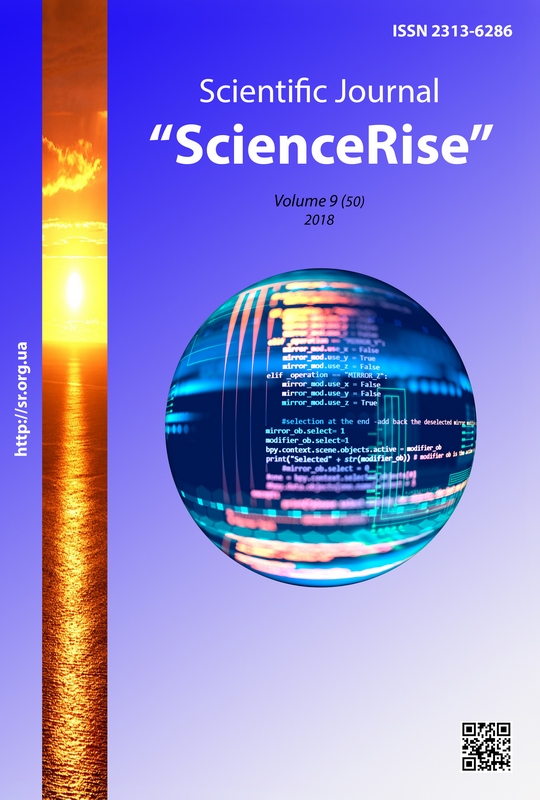Analysis of a semiconductor vibration and frequency sensor construction specifity
DOI:
https://doi.org/10.15587/2313-8416.2018.143414Keywords:
semiconductor, filamentous monocrystal, tensotransducer, resonator, frequency, sensitive element, tensor signal, deformationAbstract
The model of direct transducering tensoresistive method of semiconductor filamentous monocrystal mechanical oscillations into an electrical signal and the principle of deformation into frequency transducer (sensor) construction are considered in this paper. The connections of output tensor signal parameters with resonator own geometric dimensions, mechanical stress and elasticity of the crystals, amplitude and their mechanical oscillations frequency are established. The value of tensor signal, which arises due to bending and tension of monocrystals under cyclic loads, is estimated, the specificity of their properties and structure is revealed
References
Langdon, R. M. (1985). Resonator sensors – a rewiew. Journal of Physics E: Scientific Instruments, 18 (2), 103–115. doi: https://doi.org/10.1088/0022-3735/18/2/002
Haueis, M., Dual, J., Cavalloni, C., Gnielka, M., Buser, R. A. (2000). Packaged bulk micromachined resonant force sensor for high-temperature applications. Design, Test, Integration, and Packaging of MEMS/MOEMS. doi: https://doi.org/10.1117/12.382278
Remtema, T., Lin, L. (2001). Active frequency tuning for micro resonators by localized thermal stressing effects. Sensors and Actuators A: Physical, 91 (3), 326–332. doi: https://doi.org/10.1016/s0924-4247(01)00603-3
Sviličić, B., Mastropaolo, E., Cheung, R. (2014). A MEMS Filter Based on Ring Resonator with Electrothermal Actuation and Piezoelectric Sensing. Procedia Engineering, 87, 1406–1409. doi: https://doi.org/10.1016/j.proeng.2014.11.706
Zhang, W.-M., Hu, K.-M., Peng, Z.-K., Meng, G. (2015). Tunable Micro- and Nanomechanical Resonators. Sensors, 15 (10), 26478–26566. doi: https://doi.org/10.3390/s151026478
Liu, H., Zhang, C., Weng, Z., Guo, Y., Wang, Z. (2017). Resonance Frequency Readout Circuit for a 900 MHz SAW Device. Sensors, 17 (9), 2131. doi: https://doi.org/10.3390/s17092131
Druzhinin, A., Maryamova, I., Kutrakov, A., Liakh-Kaguy, N. (2011). Silicon whiskers for sensor electronics. Materials of XIII International conference Physics and technology of thin films and nanosystems. Ivano-Frankivsk, 1, 29.
Druzhinin, A., Kutrakov, A., Maryamova, I. (2011). Tensoresistive pressure sensors based on filamentous silicon crystals for a wide range of temperatures. Bulletin of the Lviv Polytechnic National University. Electronics, 708, 64–71.
Rak, V., Baitsar, R. (2007). A random errors estimation of the measuring generator of the resonance sensors. Sensors and systems, 5, 16–21.
Baitsar, R., Rak, V., Zelisko, Y. (2011). A temperature and pressure influence on the output frequency of the measuring generator of the resonance sensor. Measuring equipment and metrology, 72, 88–93.
Downloads
Published
Issue
Section
License
Copyright (c) 2018 Roman Baitsar, Roman Kvit

This work is licensed under a Creative Commons Attribution 4.0 International License.
Our journal abides by the Creative Commons CC BY copyright rights and permissions for open access journals.
Authors, who are published in this journal, agree to the following conditions:
1. The authors reserve the right to authorship of the work and pass the first publication right of this work to the journal under the terms of a Creative Commons CC BY, which allows others to freely distribute the published research with the obligatory reference to the authors of the original work and the first publication of the work in this journal.
2. The authors have the right to conclude separate supplement agreements that relate to non-exclusive work distribution in the form in which it has been published by the journal (for example, to upload the work to the online storage of the journal or publish it as part of a monograph), provided that the reference to the first publication of the work in this journal is included.

